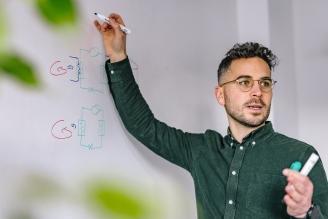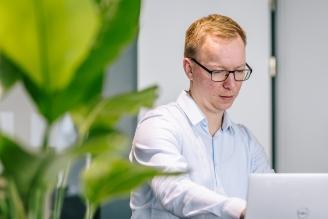ChatGPT:
We develop customised building solutions that not only meet current requirements but also future ones.
A conversation about ideas, innovations, and the future of construction
With their new brand MorgenGrün, ZWP Ingenieur-AG has made a bold statement. The goals: climate-friendly construction and shaping an environmentally conscious future. But how does MorgenGrün plan to meet these challenges? We asked the experts at MorgenGrün.
What are MorgenGrün’s innovative approaches in the areas of new builds, refurbishment of existing buildings, and neighbourhood development? Let’s start with new builds: how do you design climate-neutral buildings?
Lydia Larsen: Climate neutrality begins with the very first idea. From the outset, we pursue a holistic concept that focuses on sustainability, renewable energy, and energy efficiency.
A good example is the intelligent integration of renewable energy within the building’s structure: from photovoltaic systems and heat pumps to the utilisation of rainwater. This results in a building that requires as little energy as possible during operation — and ideally generates that energy itself.
That sounds very promising. Which innovative measures do you implement specifically?
Lydia Larsen: A key approach is the early adoption of modern technologies and sustainable materials. Already during the planning phase, we rely on innovative solutions such as digital twins, which allow us to simulate a building’s energy characteristics and required resources in advance. This way, we can minimise energy demand, CO₂ emissions, and costs before the first spade has even hit the ground.
At the same time, we work closely with architectural firms to realise construction methods that have minimal environmental impact throughout the entire lifecycle — from construction and use to eventual recycling.
How about refurbishment? How do you approach making existing buildings climate-neutral? What are your partners’ and clients’ requirements?
Jan Richarz: Making existing buildings climate-fit is one of the biggest challenges of our time. After all, the vast majority of buildings we use today will still be standing in 2045. Therefore, it is crucial to modernise existing buildings sustainably and climate-neutrally in order to meet climate targets. The operation of existing buildings in Germany accounts for around 40 per cent of total final energy demand and approximately 15 per cent of CO₂ emissions.
Building owners often have individual goals for CO₂ reduction and for meeting ESG criteria — environmental, social, and corporate governance — and require suitable energy design and well-considered investment planning. Energy design focuses on the interplay between the building envelope, energy generation, storage, and transfer to create a modern and low-carbon energy system.

The most sustainable building is the one that already exists.
Let’s take a concrete example: how do you proceed step by step, especially when it comes to all the interactions within the building?
Jan Richarz: Our approach starts with a detailed survey of the existing building: How energy-efficient is it currently? Which energy sources are used in which systems? What renewable energy potentials exist at the building’s location? Based on this, we then develop a tailored modernisation concept. The sizing of new generators, storage units, and measures related to the building envelope should be optimally coordinated to avoid lock-in effects, for example, and to maximise emissions and cost savings in building operation over the next 30 years.
What role does the digital twin play in this?
Jan Richarz: The digital representation of the building is indispensable! The multitude of physical and economic interactions, as well as the many possible modernisation measures to reduce CO₂, result in an enormous number of potential energy concept variants. This number of variants is very difficult to examine using conventional methods. That’s why we use mathematical optimisation techniques to identify and size the cost-optimal energy system for an existing building — taking into account individual CO₂ targets and all relevant interactions. We combine a physical building and system model with intelligent algorithms.
Does that mean you have to collect huge amounts of data for this?
Jan Richarz: Not necessarily more than with conventional methods. Basic data such as floor areas and annual electricity and heat consumption are available for most existing buildings. However, the precision of energy design sizing can be improved if consumption data with higher temporal resolution are available — ideally monthly, but even better hourly.
And what about neighbourhood development? How do your approaches here differ from those for new builds and existing buildings?
Julian Bartz: In neighbourhood development, we look at the bigger picture — not just individual buildings. In many cases, it becomes clear that a broader focus on the neighbourhood level can achieve significantly higher utilisation rates of renewable energy. In particular, the feed-in of excess PV electricity into the public grid can be substantially reduced. This eases the burden on public power grids while simultaneously improving the economics of the systems.
Savings can also be made in heat supply when buildings within a neighbourhood are supplied via a shared infrastructure. For example, waste heat generated in an office building (A) could be distributed through a heat network to residential buildings (B and C) instead of being vented to the outside air as is often the case.

In district development, we take a holistic view — not just focusing on individual buildings.
What exciting concepts are involved?
Julian Bartz: A truly innovative concept for new residential districts is the so-called 5th Generation District Heating and Cooling (5GDHC) infrastructure. These heating networks operate at temperatures close to ambient and can serve as both heat and cooling sources for connected buildings. Decentralised heat pumps in the connected buildings then generate the required heating. The first pilot projects for this concept are already underway in Germany.
What exactly makes 5GDHC so special?
Julian Bartz: A key advantage is that it is no longer necessary to build a separate cooling network. And due to the very low network temperatures of about 5 to 25 degrees Celsius and the associated minimal distribution losses, pipe insulation can often be omitted. It becomes particularly exciting when excess heat from commercial buildings is used to heat residential properties. The buildings in a 5GDHC network act as so-called prosumers — both producers and consumers at the same time. This smart energy balancing makes better use of waste heat potentials and simplifies the integration of renewable energies.
How important is early planning in district development?
Julian Bartz: Extremely important. If we set all the right course during the concept phase, synergies can be utilised far more effectively. The result: districts that are not only climate-neutral but also economically attractive.
And what role does digitalisation play?
Julian Bartz: A crucial one! Digital control and monitoring systems help us track and optimise energy flows within the district in real time. Data on energy demand, weather, and energy generation enable us to make the best use of resources and continuously improve the CO₂ balance. Additionally, digital systems monitor maintenance cycles and ensure efficient operation of the systems — further reducing energy consumption.
What happens when new builds and refurbishment meet in a district — how does that work?
Jan Richarz: In practice, energy-efficient new builds stand right next to renovated older buildings in a district. The new buildings are usually highly energy-efficient, have a low carbon footprint, and often already generate renewable electricity. For existing buildings, optimal modernisation strategies must be developed. In a district, intelligent networking of buildings allows heat, cooling, and electricity to be distributed within the area. High synergies arise especially with different uses such as residential and commercial, for example through the use of PV electricity and generated waste heat.
For an existing heating network within a district, it is also important to evaluate whether other nearby buildings can and should be connected to the network.
To what extent does the circular economy play a role in refurbishment?
Lydia Larsen: The circular economy is a central approach for us to build and renovate sustainably and resource-efficiently. To give you a figure: currently, only about one per cent of installed materials are reused — and we want to change that!
Our goal: to preserve and reuse as much of the existing fabric as possible. Even in refurbishment projects, we actively promote the use of recycled materials. From the planning stage onwards, we consider the reusability of newly introduced materials, so that today’s projects don’t become tomorrow’s waste.
Julian Bartz: And the circular economy is not only sustainable but also economically promising. Through design for deconstruction and high-quality, reusable materials, we increase the resale value of components — and thus the residual value of the building. A clear win for both the environment and the economy!
Even in new builds?
Lydia Larsen: Absolutely! Especially through the use of BIM, Building Information Modelling, we see enormous potential here. In collaboration with Madaster, for example, we can create a model-based life cycle assessment to better capture and optimise the sustainability of construction materials used. In this digital twin, we store not only the materials and their environmental impacts but also information on connection techniques and recyclability.
All this data forms the basis for the building resource passport. This allows us to store and use information throughout the entire lifecycle of the property.

ChatGPT:
We develop customised building solutions that not only meet current requirements but also future ones.
Sustainability and profitability — do they even go together?
Lydia Larsen: I would put it this way: without ecological sustainability, there is no profitability. Sustainable buildings have significantly lower energy costs during operation thanks to their construction and energy concepts. Starting in 2027, the cost for emitting one tonne of carbon dioxide could rise to over 200 euros. This would, for example, mean a surcharge of around five cents per kilowatt-hour for natural gas.¹
Another important point is funding opportunities. We assist our clients in making optimal use of grants from programmes such as the Federal Funding for Efficient Buildings (BEG). The “funding jungle” is often hard to navigate for many, and that’s exactly where we come in! We clarify which programmes are relevant and help our clients fully exploit their funding potential.
How do you concretely link sustainability and profitability?
Julian Bartz: Our concepts are both ecologically and economically well thought out. We develop tailored overall energy concepts that are perfectly adapted to the location. A key component is accurately determining the building’s demand. We use dynamic models and simulations that allow us to optimally align generation capacities with demand, preventing oversizing of systems.
In the field of district development, we can secure significant funding for the expansion of heating networks and energy centres through the Federal Funding for Efficient Heating Networks (BEW). We also support our clients in the application process. Our colleague Jan Benner has intensively engaged with BEW funding in the past year and has already submitted successful applications.
Requirements for certifications and legal regulations are increasing. How do you deal with that?
Lydia Larsen: Certifications like DGNB or BNB are crucial for many of our clients to demonstrate a project’s sustainability. The earlier we are involved as auditors in the process, the lower the effort and costs. We accompany our clients from the initial design phase through to final certification to ensure all requirements are smoothly met.
At the same time, sustainability requirements are increasingly becoming standard due to regulatory developments. Sustainability is no longer just a trend relevant only for flagship projects. Due to regulations such as the EU Taxonomy and the Corporate Sustainability Reporting Directive (CSRD), more and more developers and companies have to engage intensively with the topic to make their buildings and corporate practices fit for the future.
Julian Bartz: But we go a step further: We don’t just aim to meet minimum requirements, but also contribute to the creation of new, more ambitious standards through our memberships in various associations.
What does this mean specifically for your clients and partners?
Lydia Larsen: That they benefit from an integrated concept that not only offers short-term cost savings but also increases the long-term value and future viability of a project. Climate-neutral construction and refurbishment are thus not just investments in the environment but also in the attractiveness and long-term value of a property.
What would you advise property owners and investors who want to build climate-neutrally?
Julian Bartz: Definitely involve experts early on! Whether new build or refurbishment — careful planning and the use of modern technologies secure success. And of course: use funding! It can significantly reduce financial costs.